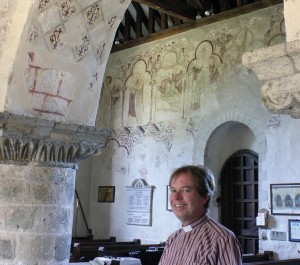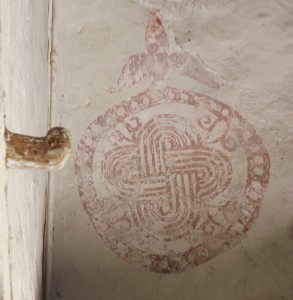
The frescoes at St Mary’s parish church in West Chiltington, Sussex, were uncovered in 1882. Contemporary 19th century records note their excellent colour. Conservation work was not undertaken until the 1930s.
Frescoes are wall paintings, painted directly on to the plaster while it is still wet. The artist has to work quickly as the pigments and image are fixed as the plaster dries. This technique was used throughout the Renaissance in Italy and elsewhere.
Amongst the earliest paintings at St Mary’s is the cross motif, formed from an endless rope knot. This beautiful cross is easily missed and forms part of a circular medallion in the recess over the east end of the south aisle. Such crosses are known in Roman mosaics and wall paintings. In Sussex, the pavement at Fishbourne Roman Palace contains a similar emblem. However, its significance at West Chiltington remains unknown. This Celtic cross design has been reinterpreted for the 21st century in the new porch with its glass doors. The Reverend David Beale, Vicar of St Mary’s, remarks: “I love the way that the newest part of the church is linked with the oldest by this cross and bears witness to Christians in this building for almost 900 years.”


On the north side of the arcade in the nave is a cycle of frescoes, which tell the story from Jesus’ triumphal entry into Jerusalem on a donkey as the crowds lay palm leaves before him, to his resurrection on the first Easter Day. Illustrated here are depictions of the Last Supper, Christ washing the feet of his disciples, the betrayal of Jesus in the garden of Gethsemane by Judas Iscariot’s kiss, the flagellation of Christ, the carrying of the cross and the crucifixion. The scenes are portrayed within a series of three painted, lobed arches resting on slender columns and capitals. The influence of the Gothic can be seen in the figures, whose fluidity conveys genuine humanity. Compassion and suffering are clearly discernable in the depictions of Christ and contrast with the expressions on the faces of his tormentors. The directness of these paintings still powerfully communicate these familiar Gospel narratives in their now faded hues. I ask David what effect these medieval fresco drawings have on him and those who visit this place week by week to worship or pray. “They have a remarkable ability to connect people with their stories,” he answers. “This place is steeped in centuries of prayer; it is fascinating to observe how this and the pictures still cause people to pause in wonder. I suppose it should be unsurprising really in our visual age.”
We have become used to the soft hues of stone and white lime wash in the majority of our churches but St Mary’s, with her faded frescoes, allows us to experience something of the extraordinary effect that these Pre-Reformation paintings would have had on Sussex people some 800 years ago. David concludes, “It’s wonderful to glimpse how rich and colourful many of our churches would have been in the 12th and 13th centuries.”
This remarkable group of colourful frescoes reside in a working building at the heart of its community and speak of a narrative common to us all. St Mary’s, West Chiltington, is open every day and is one of my favourite places to stop and pray – a generous punctuation mark in a busy day. Treat yourself and try it! Easter services will be held at 2.00pm on Good Friday with Holy Communion on Easter Sunday at 8.00am and 10.00am. All are welcome. For more information go to www.stmaryswestchilt.co.uk
By Revd. Rupert Toovey. Originally published on 18th April 2014 in the West Sussex Gazette.